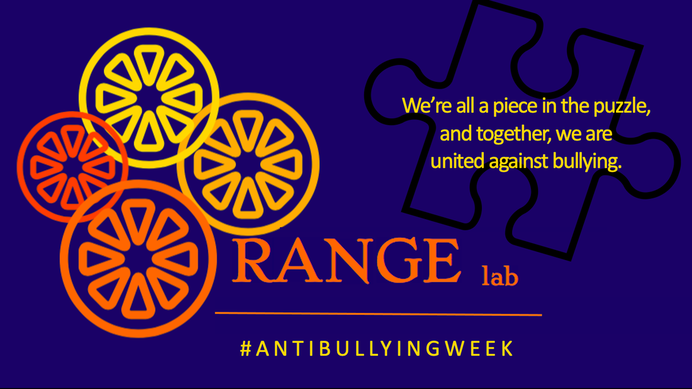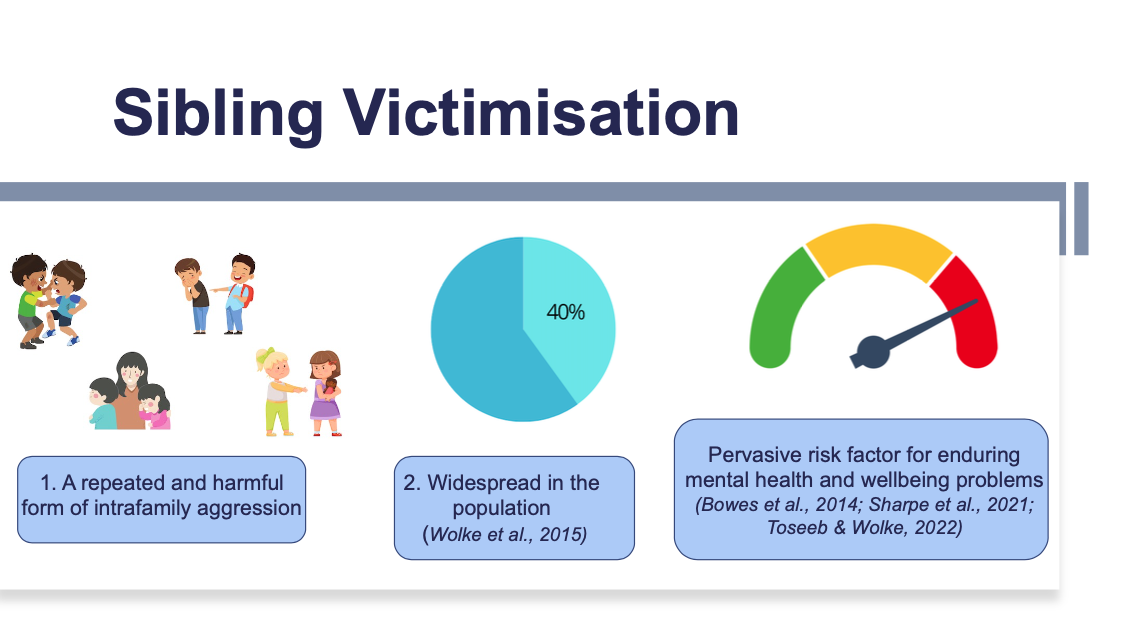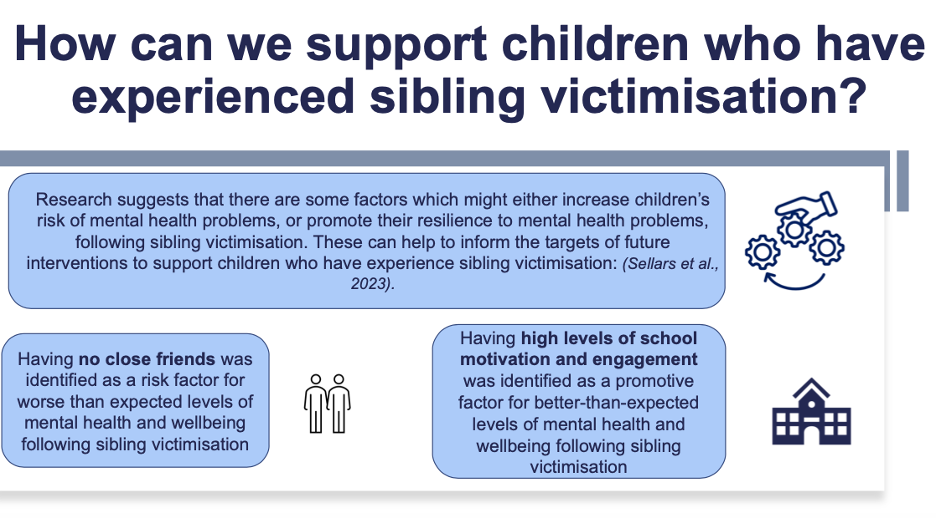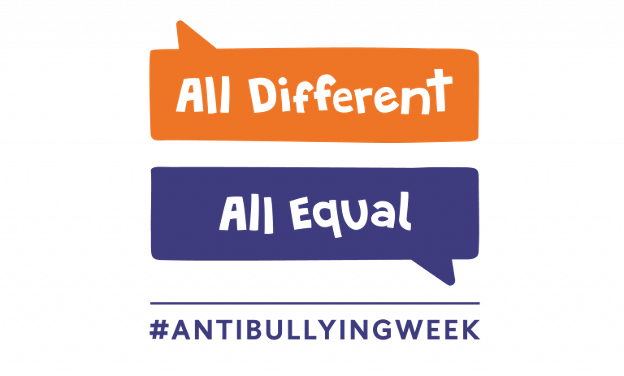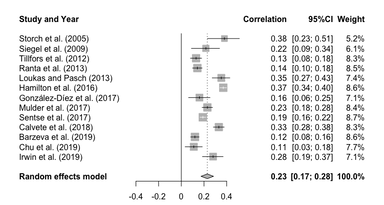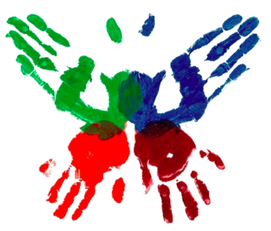BULLYING & MENTAL HEALTH
|
|
Why we should care about sibling bullying Bullying doesn’t just happen at school. Research suggests that around 40% of young people are bullied by a sibling Although many siblings experience occasional conflict, some sibling relationships can be a source of victimization. Sibling victimization is a harmful and repeated form of intrafamily aggression. We explored longitudinal associations between sibling victimization and mental health and wellbeing outcomes, and promotive and risk factors that predicted better or worse outcomes following victimization. We used data from >12,000 participants in the Millennium Cohort Study, a longitudinal UK birth cohort, who reported on sibling victimization at age 11 and/or 14 years. We found that over and above pre-existing individual and family level vulnerabilities, experiencing sibling victimization was associated with significantly worse mental health and wellbeing. Having no close friends was a risk factor for worse-than-expected outcomes following victimization. Higher levels of school motivation and engagement was a promotive factor for better-than-expected outcomes. This indicates that aspects of the school environment may offer both risk and promotive factors for children experiencing sibling victimization at home. We argue that effective sibling victimization interventions should be extended to include a focus on factors at the school level. Link to paper: https://doi.org/10.1017/S0954579423001323 Researchers: Elise Sellars, Bonamy Oliver and Lucy Bowes |
Adapting an anti-bullying programme for UK special schools
|
Differently abled children (including those with visible/non-visible disabilities, SEND, neurodiversity or chronic conditions) are more likely to be bullied than their peers. In the Orange Lab we are conducting research to understand how we can better support children and young people with different needs.
We identified a lack of evidence-based anti-bullying programmes or interventions designed for use in special schools. KiVa is a successful anti-bullying programme for mainstream schools currently used in 23 countries. We are working to co-develop and adapt the successful KiVa anti-bullying programme for use in special schools in the UK. In a recent paper, we describe the development and adaptation of two KiVa lessons into KiVa-SEND lessons and their implementation in two special schools in the UK. nasenjournals.onlinelibrary.wiley.com/doi/10.1111/1467-9604.12457 Researchers working in this area: Dr Julia Badger, Dr Sinziana Oncioiu, Olivia Cheriton, Professor Lucy Bowes |
|
LGBTQ+ youth and bullying
Sexual minority youth are more likely to be bullied, and to experience poor mental health. Sexual minority youth consistently demonstrate higher rates of mental health problems compared to heterosexual adolescents. Sexual minority youth exhibit 3·5 times the risk of attempting suicide compared to heterosexual peers, with around a third of individuals having self-harmed (Liu et al., 2019; di Giacomo et al., 2018). Considering these harmful outcomes, it is important to understand why this group is particularly vulnerable to suicide and self-harm, and how to offset this vulnerability. Researchers from our lab are using data from large, longitudinal datasets to better understand the complex relationships between bullying and mental health outcomes in sexual minority youth. Researchers working in this area: Irena Tetkovic and Jack Andrews |
|
Social Anxiety and Peer Relationships
We have recently published a systematic review and meta-analysis looking at the relationship between social anxiety and later peer relations (friendship quality, peer acceptance, peer rejection, and peer victimisation), and also peer relations and later social anxiety, in adolescents. From 23 studies, we found a significant association in both directions between social anxiety and peer rejection, peer victimisation, and friendship quality. This suggests that we need to help young people to develop healthy supportive friendships to reduce the risk of developing social anxiety. Similarly, helping teenagers feel more socially confident may protect them from peer difficulties in the future. Researchers: Eleanor Leigh, OxCADAT, Sophie Grant |
WHAT CAN WE DO ABOUT IT?
|
STAND TOGETHER
Supporting Children’s Social and Emotional Wellbeing Over 25% of UK children report being bullied at least weekly. These children are more likely to experience poor mental health, achieve less academically and are more likely to experience health-related problems into adulthood. As part of the Stand Together Trial, we are collaborating with researchers at Bangor, Warwick, Exeter and Cardiff universities to evaluate the effectiveness of a whole-school anti-bullying and wellbeing programme called KiVa, at reducing bullying rates and improving child mental health and school enjoyment in the UK. KiVa involves scripted lessons, class activities, games, school assemblies and many other strategies and materials to promote wellbeing and reduce bullying. The Stand Together trial is funded by NIHR with generous support from the Rayne Foundation. Find out more: standtogethertrial.weebly.com Researchers: Lucy Bowes, Julia Badger, Carolina Guzman Holst, Katerina Romanova |
|
Social Norms in Low & Middle Income Contexts
Social norms appear to influence the prevalence rates of bullying and thus may provide a promising path to intervention. There is a lack of evidence for the effectiveness of anti-bullying programs targeting social norms in low- and middle-income countries. In partnership with UNICEF Indonesia, we carried out a feasibility trial with more than 14,000 students in two different regions in Indonesia. Our results indicated that the extent to which negative behaviours were accepted as social norms by students was associated with how much they would engage in bullying, both as perpetrators and as victims. Further, following the intervention, negative social norms tended to decrease across all 12 schools in our sample and particularly so in schools with more negative social norms prior to the intervention. https://www.tandfonline.com/doi/abs/10.1080/16549716.2019.1656905 https://link.springer.com/article/10.1007/s42380-023-00176-8 Researchers: Lucy Bowes, Mirela Zaneva |

